Most people who have visited Rome will know that, like most capitals in Europe, the majority of attractions and sights are in a compact area. Taking advantage of this I want to draw attention to three sites with an underground theme: the Domus Aurea, Bascilica di San Clemente and Basilica Santi Giovanni e Paolo. Not only do they transport us back to early Imperial times but they are well placed for a quiet and short stroll with elements of lost temples, interesting bye stories and times further back to the Republic.

There is so much that can be said about the Domus Aurea, Nero’s ‘Golden Palace’, for the sake of brevity I will concentrate on a few aspects. There will be a link at the end of this paragraph which will give more information. It is an absolute must see for anyone visiting Rome. Firstly, Google Maps has the Domus Aurea at the north of the park but the entrance (and exit) are at the south. Arrive ten minutes before your alloted tour time as you will have to be kitted out with high viz and hard hat – it is an ongoing archaeological site. Be prepared for a cold, damp interior – I am not sure how this can be tackled in summer but, as we tend to travel in spring and autumn, we were glad of our extra layer (the Scotsman who was in our group in a T-shirt and kilt, assured us that Scots are hardy types, certainly did not look too hardy at the end of the tour). All this built the excitement of getting in there and it really does not disappoint. There is a slide show projected on the wall at the entrance and it is at this stage that an idea of the sheer scale and decoration of the palace.
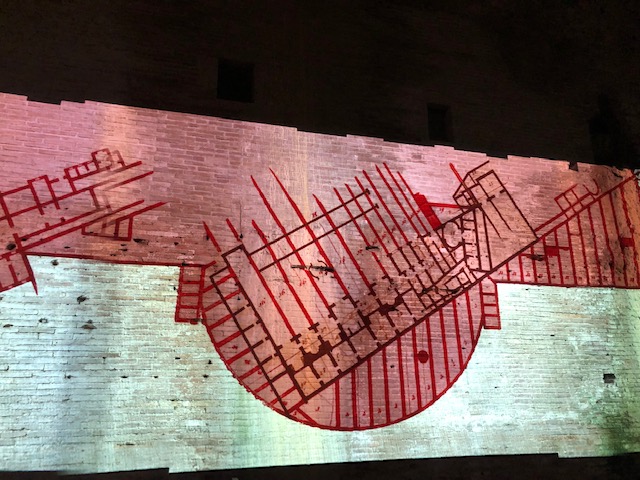


Regarding the scale, yes, we know Suetonius describes the triple Portico overlooking the lake as a mile long, Nero’s Bronze statue in the courtyard being 120ft high (which was said emulated the Colossus of Rhodes and, when moved to the Flavian Amphitheatre, gave it it’s name of the Colossium) but these seem abstract until faced with the actual building. Enormous though it is, it is still only the 10,000sq ft of Imperial rooms which remain, the rest lost, and of this the public have access to 32 of the 150. These facts, when you walk round the huge vaulted passageways with what seems to be a myriad of different rooms starts to put the sheer enormity of the palace into perspective. It’s at this point I want to stop and wonder, covered by Trajan to give a firm base for his baths complex, what the boy, and subsequent rescuers and those who followed with their lanterns and torches must have thought when he fell through a hole in the ground in the fifteenth century. Today, the holes breaking through the frescoes and decorations can be seen where people gained access to the different passageways. Even so, the ceiling would have been at head height or even lower as they would have been standing on infill and spoil. Whilst this gave them a good close up of the decorations they would probably been astonished to appreciate just how deep this was.
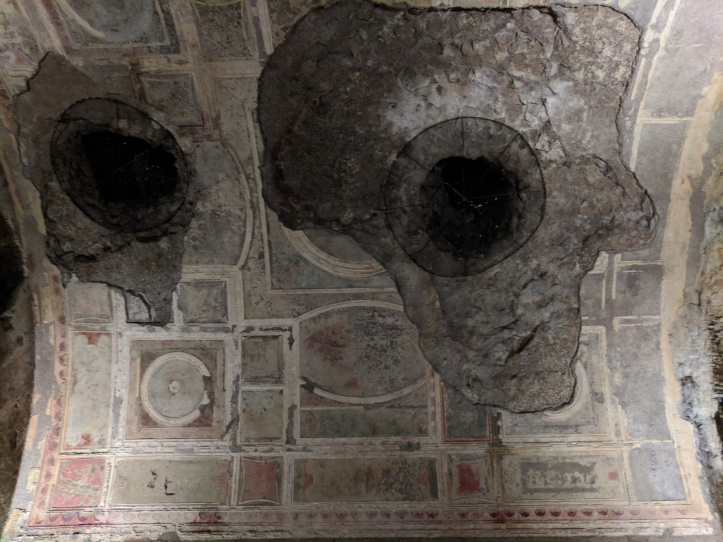
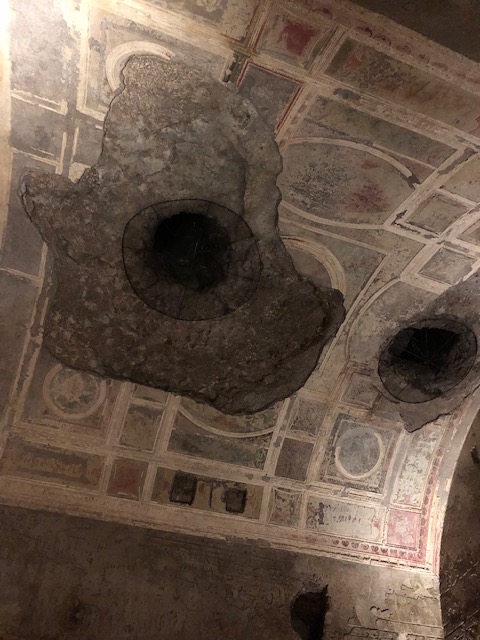

Although the frescoes have faded, a mixture of salt crystallization, calcium deposits, pollutant crusts, and biological growth with the parkland above not helping, they are nevertheless impressive, again, the scale and number of decorations being the key.




The passageways you can see seem to almost be endless, don’t forget this is only a very small part of the palace, and we enter a circular room with a large nyphaeum to one wall. Aha, I thought, this is the famed revolving dining room that Suetonius described. Although apparently I am not the first to think that – apparently not it has now been decided. Although disappointed I take comfort, therefore, that it is still waiting to be discovered somewhere over on the Palatine. Still an impressive room though.



Incredible though this is, for me, they saved the best to last. It is the first time I had experienced VR (virtual reality) and, having strapped on the goggles – well, words can hardly describe it. Transported back to Neronian times the reconstructed tour with the fresh vibrant colours and explanations of different rooms was completely emersive. Moving through the Portico we then hovered over the sunny gardens with views of first century Rome in the distance. To say it is emotional is an understatement – we literally wept. Suffice it to say we are technology converts. Along with the Baths of Caracalla I now hear the Circus Maximus has a 3-D experience – next time, next time. Anyway, as promised, here is more information on the Domus Aurea.
Exiting the Domus Aurea it is a short walk down the park path to the road. The Colosseum is directly in front, remember it was built on the drained lake of the Domus Aurea so, again, gives a sense of the sheer scale of the palace. Turn left at the end, across the Via Labicana and the first left from the Piazza del Colosseo. Linger to take in the Ludus Magnus, an arena thought to be a gladatorial training ground and then onward to Basilica San Clemente.
Under San Clemente there is a journey back to the first century but, before that, go into the main body of the church and look down at the floor. All the pieces of marble are reclaimed from the interior and exterios of Roman buldings – the round ’tiles’ are from columns that have been sliced and then laid. So, this gives a sense of the how colourful Rome must have been and perhaps gives some weight to Suetonius’ Augustus quote that that he found a city of bricks, but left it of marble. Certainly it is worth spending a few minutes with closed eyes to speculate the context of the different marbles and visualise how it must have looked.

Time to go underground. The current visible church dates from the 11th Century and it was only in the 19th Century, because some Irish Dominican monks got inquisitive, that they found that current church is built on a 5th Century Church which, in turn was built on a Mithreum and earlier warehouse or possibly a mint. Over two floors this is one of the most fascinating walk back in time. Not only to the structures change but the materials as well. The 5th Century walls are temple like with columns, filled with blocks. However, as we go down and therefore back in time the passageways become narrower, the rooms lower and the building material becomes Roman brick. The Mithream appears beautifully preserved and complete and the room is suitably rough and low roofed – everything I imagine that might intensify the religious experience.

The passageways now get narrower and there is a room with brick walls and floor, the light is dimmer and there is the atmospheric sound of running water. Opinion is devided as to whether this is a warehouse or a first century mint. I so want it to be the latter – I love to speculate which coins would have been minted here. Would it be Augustus claiming divine heritage or perhaps Nero, with his thick neck proclaiming his artistic qualities. One thing is sure, the mint would have been very busy in the year of four emperors! Whatever the function of the room, it is a thrill to be able to walk on, reach out and touch walls with 2000 years of history.
From the Basilica di San Clemente find your way back to the Via Claudia and turn left up the hill. Interestingly the pavement separates two thousand years, the Via Claudia is the coach drop off point for modern day tourists but on the right there is a section of old wall. This is one of the few remaining fragments of the large Temple of Claudius, a structure Nero removed. The niches probably displayed statues. There will be another fragment visible when we get to the Basilica Santi Giovanni e Paolo.

A little further up the Via Claudia it is time to turn right into the Via Clivo di Scauro (marked on the Google map as Via di S Paolo della Croce). At the entrance of the road is the Arch of Dolabella. Built by senatorial decree in 10 CE it is likely a replacement for a gate through the Servian Wall. During the Principate of Nero the Aqua Claudia was extended which was incorporated into the Arch of Dolabella. I have to say that walking though this old gate I felt a thrill knowing that I was now walking towards the footsteps of Republican times.
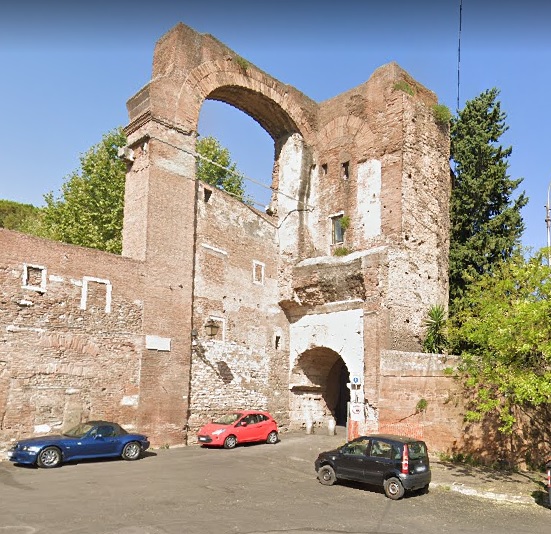

After a short stroll you will see the Basilica Santi Giovanni e Paolo on your right and easily recognisable by the 11th century bell tower. Built in 398 BCE after two Roman soldiers, John and Paul, were martyred by Julian, the church has had an eventful history including being damaged during the sack by Aleric in 410, an earthquake and again during the sacking by the Normans in 1084. As an aside, the church has a unique and unusual feature. During the last renovation, Francis Cardinal Spellman, Archbishop of New York and titular of the church, obtained financial support from Joseph Kennedy to restore the exterior reflecting medieval times and the interior where he installed the chandeliers from the Waldorf-Astoria hotel which was undergoing refurbishment.


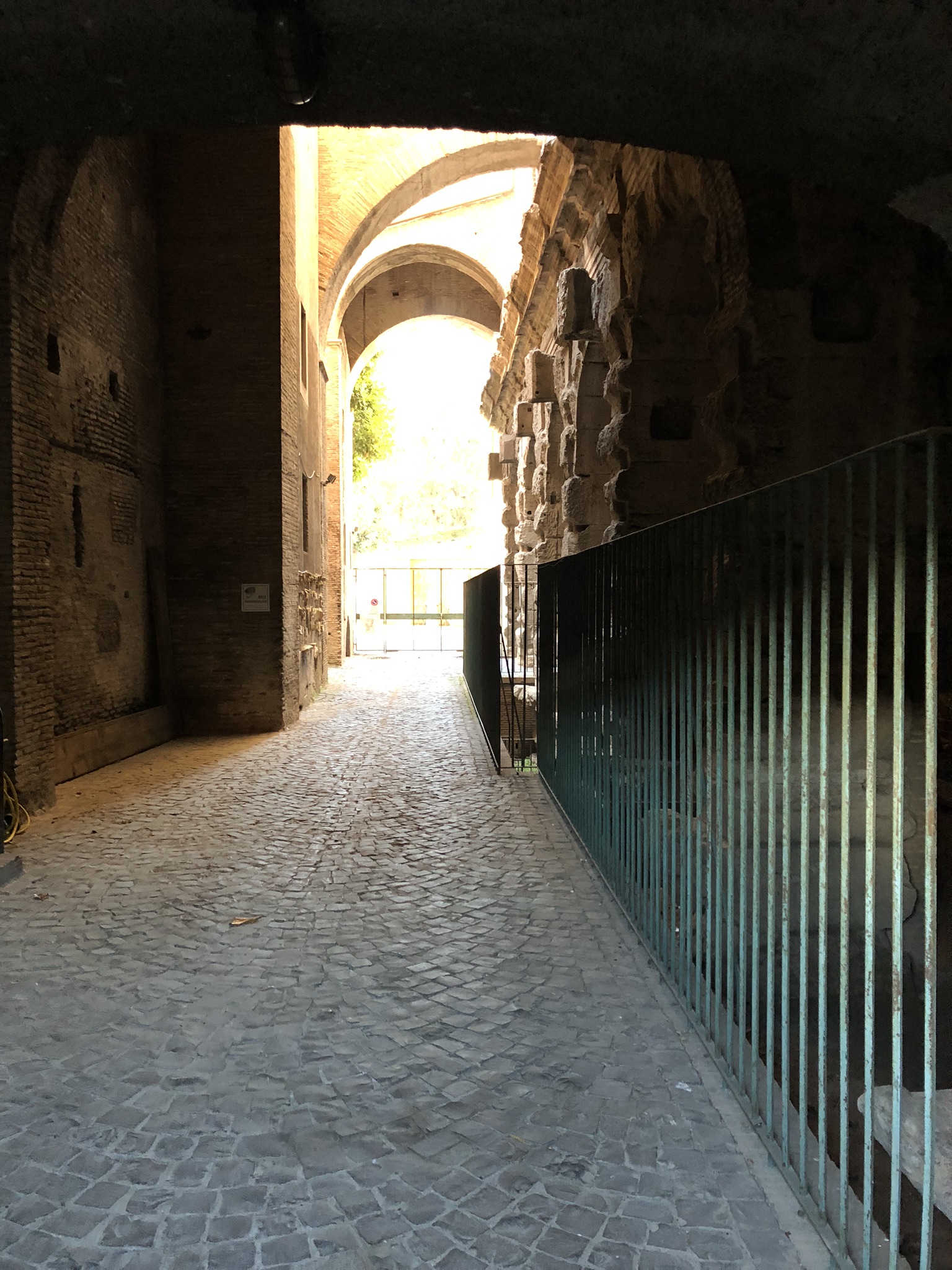

Anyway, back to Roman times. Across the car park of the Basilica Santi Giovanni e Paolo and, both to the right of and through the railings, there is another fragment Temple of Claudius. Bearing in mind the remains of the wall on the Via Claudia and the distance walked along the Via Clivo di Scauro it gives an idea of just how impressive and extensive Imperial projects were.
Unusual and interesting though the basilica is, the real gem is not the church but what is underneath it. Acting on rumours that the martyrs were buried there a search was undertaken in 1887 which unexpectedly revealed 20 small houses and tabernae dating from the second century which had undergone a transformation into one large house in the fourth century. I say a gem, not just because of the find dating back nearly 2000 years but, although the normal tourist sites were very busy, because this is slightly off the beaten track we were the only visitors there. The entrance can be found by leaving the church car park and turning right, at this point the road transforms into the cobbled Clivus Scauri – now the Republican road, and is on the right behind the church.
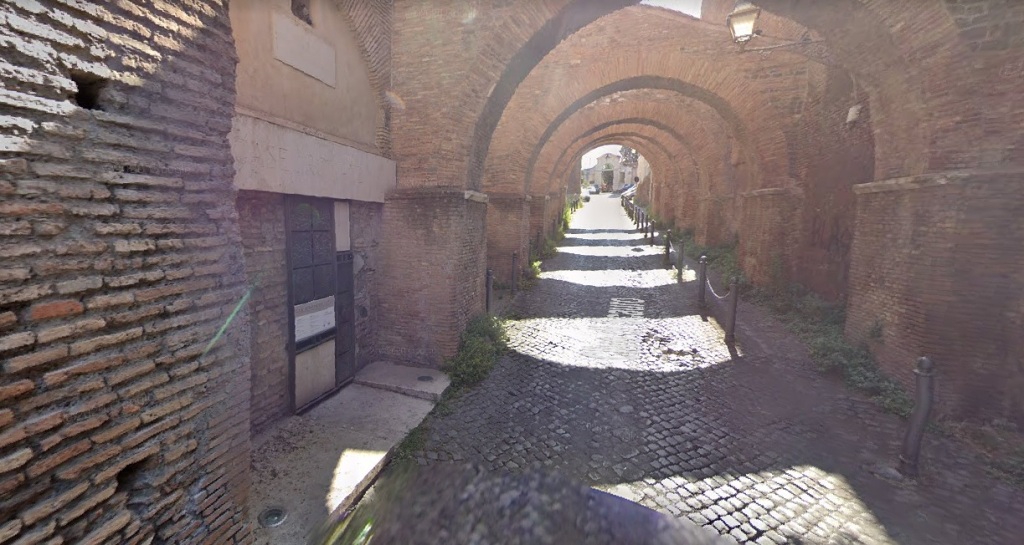
The Case Romane del Celio is everything that you could possibly want. A labrynth of rooms and passages over several levels with frescoes which are a wonder. For those who are interested in material culture lifetimes and journeys, the frescoes showing naked people have had their genitals ‘erased’ by the clergy to prevent viewers being corrupted (at least according to our guide).
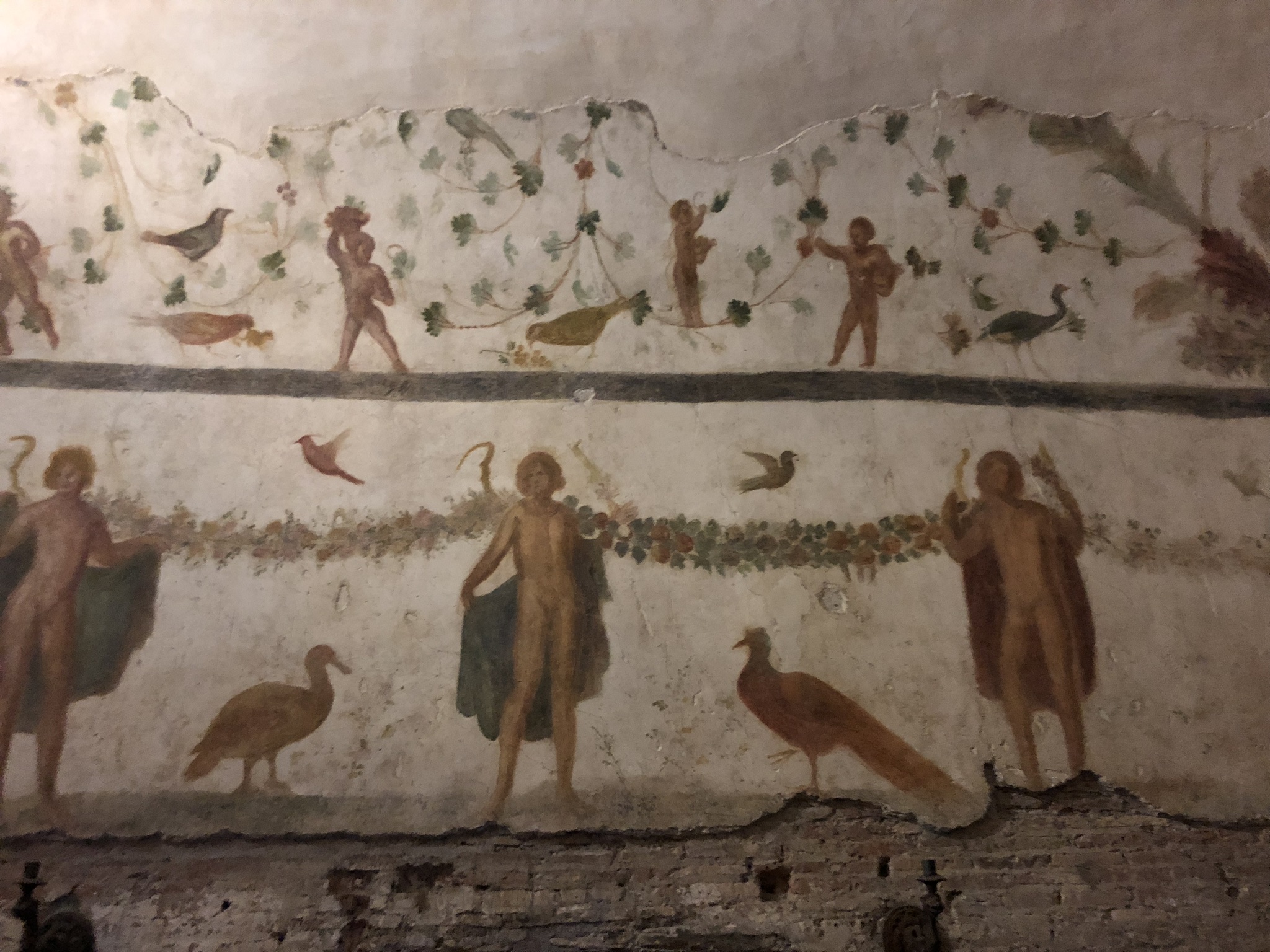







From the Case Romane del Celio turn right down the Clivus Scauri. It is an easy, leisurely stroll to the bottom where it’s possible to cut down a small bank onto the Viale di Parco del Celio which will bring you back to the Colosseum with the Arch of Constantine on your left. As we stroll down I think it fun to imagine some of the experiences of people from the past: the fear, bloodshed and proscriptions of the civil strife towards the end of the Republic, the construction and destruction of immense Imperial projects, the ebbing and flowing of Christianity and Aleric sacking Rome. I think the sounscape must have also been fascinating: the sound of 250,000 spectators in the Circus Maximus as they cheer on their favourites, the sounds of 50,000 people and possibly beasts in the Colosseum or even the sounds of the trumpets, wagons and marching, singing soldiers as they take part in a triumph – all these were in a few hundred metres.
I hope you enjoyed the walk, sights, speculation, imagination and information.
Extremely well-written account of a fabulous walk incorporating so many venues of real interest. Thank you.
LikeLiked by 1 person
Glad you liked it – there’s so much more to Rome than you can see on the surface
LikeLike
To say I ‘liked’ it is a huge understatement – I loved it. So keep your blogs going please.
LikeLiked by 1 person
Hello Sir,
Very interesting ! Could you please inform me on booking admittance and/tour information? Traveling to Rome in late August and this undergrounds experience is a MUST !
Any help would be greatly appreciated ! Joshua Kornegay on Facebook ( where I first saw your great article)
LikeLike